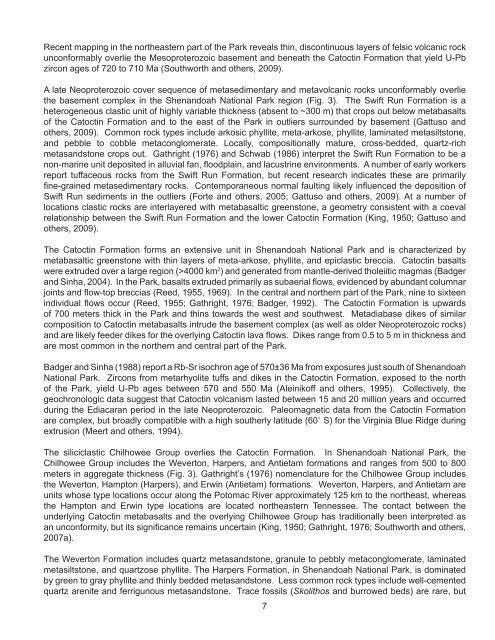Geology of the Shenandoah National Park Region - Csmres Jmu ...
Geology of the Shenandoah National Park Region - Csmres Jmu ...
Geology of the Shenandoah National Park Region - Csmres Jmu ...
You also want an ePaper? Increase the reach of your titles
YUMPU automatically turns print PDFs into web optimized ePapers that Google loves.
Recent mapping in <strong>the</strong> nor<strong>the</strong>astern part <strong>of</strong> <strong>the</strong> <strong>Park</strong> reveals thin, discontinuous layers <strong>of</strong> felsic volcanic rock<br />
unconformably overlie <strong>the</strong> Mesoproterozoic basement and beneath <strong>the</strong> Catoctin Formation that yield U-Pb<br />
zircon ages <strong>of</strong> 720 to 710 Ma (Southworth and o<strong>the</strong>rs, 2009).<br />
A late Neoproterozoic cover sequence <strong>of</strong> metasedimentary and metavolcanic rocks unconformably overlie<br />
<strong>the</strong> basement complex in <strong>the</strong> <strong>Shenandoah</strong> <strong>National</strong> <strong>Park</strong> region (Fig. 3). The Swift Run Formation is a<br />
heterogeneous clastic unit <strong>of</strong> highly variable thickness (absent to ~300 m) that crops out below metabasalts<br />
<strong>of</strong> <strong>the</strong> Catoctin Formation and to <strong>the</strong> east <strong>of</strong> <strong>the</strong> <strong>Park</strong> in outliers surrounded by basement (Gattuso and<br />
o<strong>the</strong>rs, 2009). Common rock types include arkosic phyllite, meta-arkose, phyllite, laminated metasiltstone,<br />
and pebble to cobble metaconglomerate. Locally, compositionally mature, cross-bedded, quartz-rich<br />
metasandstone crops out. Gathright (1976) and Schwab (1986) interpret <strong>the</strong> Swift Run Formation to be a<br />
non-marine unit deposited in alluvial fan, floodplain, and lacustrine environments. A number <strong>of</strong> early workers<br />
report tuffaceous rocks from <strong>the</strong> Swift Run Formation, but recent research indicates <strong>the</strong>se are primarily<br />
fine-grained metasedimentary rocks. Contemporaneous normal faulting likely influenced <strong>the</strong> deposition <strong>of</strong><br />
Swift Run sediments in <strong>the</strong> outliers (Forte and o<strong>the</strong>rs, 2005; Gattuso and o<strong>the</strong>rs, 2009). At a number <strong>of</strong><br />
locations clastic rocks are interlayered with metabasaltic greenstone, a geometry consistent with a coeval<br />
relationship between <strong>the</strong> Swift Run Formation and <strong>the</strong> lower Catoctin Formation (King, 1950; Gattuso and<br />
o<strong>the</strong>rs, 2009).<br />
The Catoctin Formation forms an extensive unit in <strong>Shenandoah</strong> <strong>National</strong> <strong>Park</strong> and is characterized by<br />
metabasaltic greenstone with thin layers <strong>of</strong> meta-arkose, phyllite, and epiclastic breccia. Catoctin basalts<br />
were extruded over a large region (>4000 km 2 ) and generated from mantle-derived tholeiitic magmas (Badger<br />
and Sinha, 2004). In <strong>the</strong> <strong>Park</strong>, basalts extruded primarily as subaerial flows, evidenced by abundant columnar<br />
joints and flow-top breccias (Reed, 1955, 1969). In <strong>the</strong> central and nor<strong>the</strong>rn part <strong>of</strong> <strong>the</strong> <strong>Park</strong>, nine to sixteen<br />
individual flows occur (Reed, 1955; Gathright, 1976; Badger, 1992). The Catoctin Formation is upwards<br />
<strong>of</strong> 700 meters thick in <strong>the</strong> <strong>Park</strong> and thins towards <strong>the</strong> west and southwest. Metadiabase dikes <strong>of</strong> similar<br />
composition to Catoctin metabasalts intrude <strong>the</strong> basement complex (as well as older Neoproterozoic rocks)<br />
and are likely feeder dikes for <strong>the</strong> overlying Catoctin lava flows. Dikes range from 0.5 to 5 m in thickness and<br />
are most common in <strong>the</strong> nor<strong>the</strong>rn and central part <strong>of</strong> <strong>the</strong> <strong>Park</strong>.<br />
Badger and Sinha (1988) report a Rb-Sr isochron age <strong>of</strong> 570±36 Ma from exposures just south <strong>of</strong> <strong>Shenandoah</strong><br />
<strong>National</strong> <strong>Park</strong>. Zircons from metarhyolite tuffs and dikes in <strong>the</strong> Catoctin Formation, exposed to <strong>the</strong> north<br />
<strong>of</strong> <strong>the</strong> <strong>Park</strong>, yield U-Pb ages between 570 and 550 Ma (Aleinik<strong>of</strong>f and o<strong>the</strong>rs, 1995). Collectively, <strong>the</strong><br />
geochronologic data suggest that Catoctin volcanism lasted between 15 and 20 million years and occurred<br />
during <strong>the</strong> Ediacaran period in <strong>the</strong> late Neoproterozoic. Paleomagnetic data from <strong>the</strong> Catoctin Formation<br />
are complex, but broadly compatible with a high sou<strong>the</strong>rly latitude (60˚ S) for <strong>the</strong> Virginia Blue Ridge during<br />
extrusion (Meert and o<strong>the</strong>rs, 1994).<br />
The siliciclastic Chilhowee Group overlies <strong>the</strong> Catoctin Formation. In <strong>Shenandoah</strong> <strong>National</strong> <strong>Park</strong>, <strong>the</strong><br />
Chilhowee Group includes <strong>the</strong> Weverton, Harpers, and Antietam formations and ranges from 500 to 800<br />
meters in aggregate thickness (Fig. 3). Gathright’s (1976) nomenclature for <strong>the</strong> Chilhowee Group includes<br />
<strong>the</strong> Weverton, Hampton (Harpers), and Erwin (Antietam) formations. Weverton, Harpers, and Antietam are<br />
units whose type locations occur along <strong>the</strong> Potomac River approximately 125 km to <strong>the</strong> nor<strong>the</strong>ast, whereas<br />
<strong>the</strong> Hampton and Erwin type locations are located nor<strong>the</strong>astern Tennessee. The contact between <strong>the</strong><br />
underlying Catoctin metabasalts and <strong>the</strong> overlying Chilhowee Group has traditionally been interpreted as<br />
an unconformity, but its significance remains uncertain (King, 1950; Gathright, 1976; Southworth and o<strong>the</strong>rs,<br />
2007a).<br />
The Weverton Formation includes quartz metasandstone, granule to pebbly metaconglomerate, laminated<br />
metasiltstone, and quartzose phyllite. The Harpers Formation, in <strong>Shenandoah</strong> <strong>National</strong> <strong>Park</strong>, is dominated<br />
by green to gray phyllite and thinly bedded metasandstone. Less common rock types include well-cemented<br />
quartz arenite and ferrigunous metasandstone. Trace fossils (Skolithos and burrowed beds) are rare, but<br />
7


